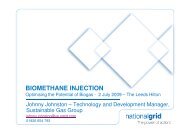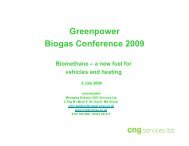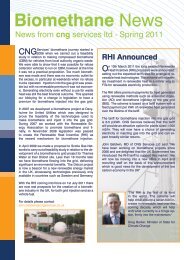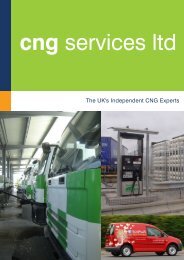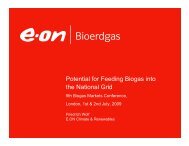Bio-SNG - CNG Services
Bio-SNG - CNG Services
Bio-SNG - CNG Services
Create successful ePaper yourself
Turn your PDF publications into a flip-book with our unique Google optimized e-Paper software.
BIO-<strong>SNG</strong> FEASIBILITY STUDY – ESTABLISHMENT OF A REGIONAL PROJECTParameter Small LargeInputEnergy rating (energy per hour) 50MW th (180GJ/hr) 300MWth (1080GJ/hr)Input fuel energy per annum 0.4TWh th (1.3PJ) 2.4 TWh th (8.6PJ)<strong>Bio</strong>mass fuel (pellets, 16GJ/te) pa 81,000 te pa 486,000 te pa<strong>Bio</strong>mass fuel (Woodchip, 13GJ/te) pa 100,000 te pa 600,000 te paSolid Recovered fuel (18GJ/te) te pa 72,000te pa 432,000 te paOperation Load factors (hrs pa) 7200 7200Baseline Efficiency to <strong>SNG</strong> 44 65% 65%Output<strong>Bio</strong>-<strong>SNG</strong> MWth 32.5MWth 195MWth<strong>Bio</strong>-<strong>SNG</strong> GJ/Hr 117 702<strong>Bio</strong>-<strong>SNG</strong> therm/hr 1110 6,650<strong>Bio</strong>-<strong>SNG</strong> Nm 3 /hr 3330 20,000<strong>Bio</strong>-<strong>SNG</strong> energy per annum 0.23 TWh th (0.84PJ) 1.40 TWh th (5.05PJ)Equivalent Households ~15,000 ~100,000Equivalent Passenger Vehicles ~25,000 ~150,000Comparative Electrical facility (no <strong>SNG</strong>) 12MWe (24%efficiency assuminggas engines)Table 6-1 Project scale and output assumptions6.1.2 Investment Cost assumptions90MWe (30% efficientbased on an IGCCconfiguration)As discussed previously, there are currently no commercial scale <strong>Bio</strong>-<strong>SNG</strong> facilities in operation, andthere is only a limited number of biomass gasification facilities which create a syngas of sufficient qualityfor catalytic conversion, with still fewer operating on waste derived fuels. Therefore investment costassumptions are estimates, however these are sufficient to enable an understanding of the economics ofthe process, given that even estimates from suppliers are only +/-30% after a formal engineering study.The following investment costs are dominated by the capital costs of the materials handling, gasifier, gasprocessing, methanation and conditioning for injection. The costs also allow for utilities and services,including grid/gas connection and indirect costs (design, development, constructionmanagement/commissioning and contingency).The cost of performance guarantees being provided by an EPC cannot be readily ascertained at thisstage, as they will depend on both the detailed requirements of the funder, and also the EPC‟s appetitefor the sector combined with the ability to cascade the guarantees down the supply chain. Suchguarantees would form part of detail project negotiations, and are not included here. Final out-turn costsare a function of the final design, the financing route and cost of risk transfer as well as general economicissues including exchange rates, appetite for an EPC contractor to undertake the work and competitionfor supply in a sector with an immature supply chain. The cost estimates below are developed using thea range of data sources:44 Based on Pellets or SRF. Where the fuel has higher moisture content (eg woodchips, modelled here at 25%), thetotal efficiency can be higher when low grade waste heat is utilised to pre-dry the fuel prior to gasification. 65% isconsidered a credible conversion efficiency using existing gasifier and methanation combinations.45



